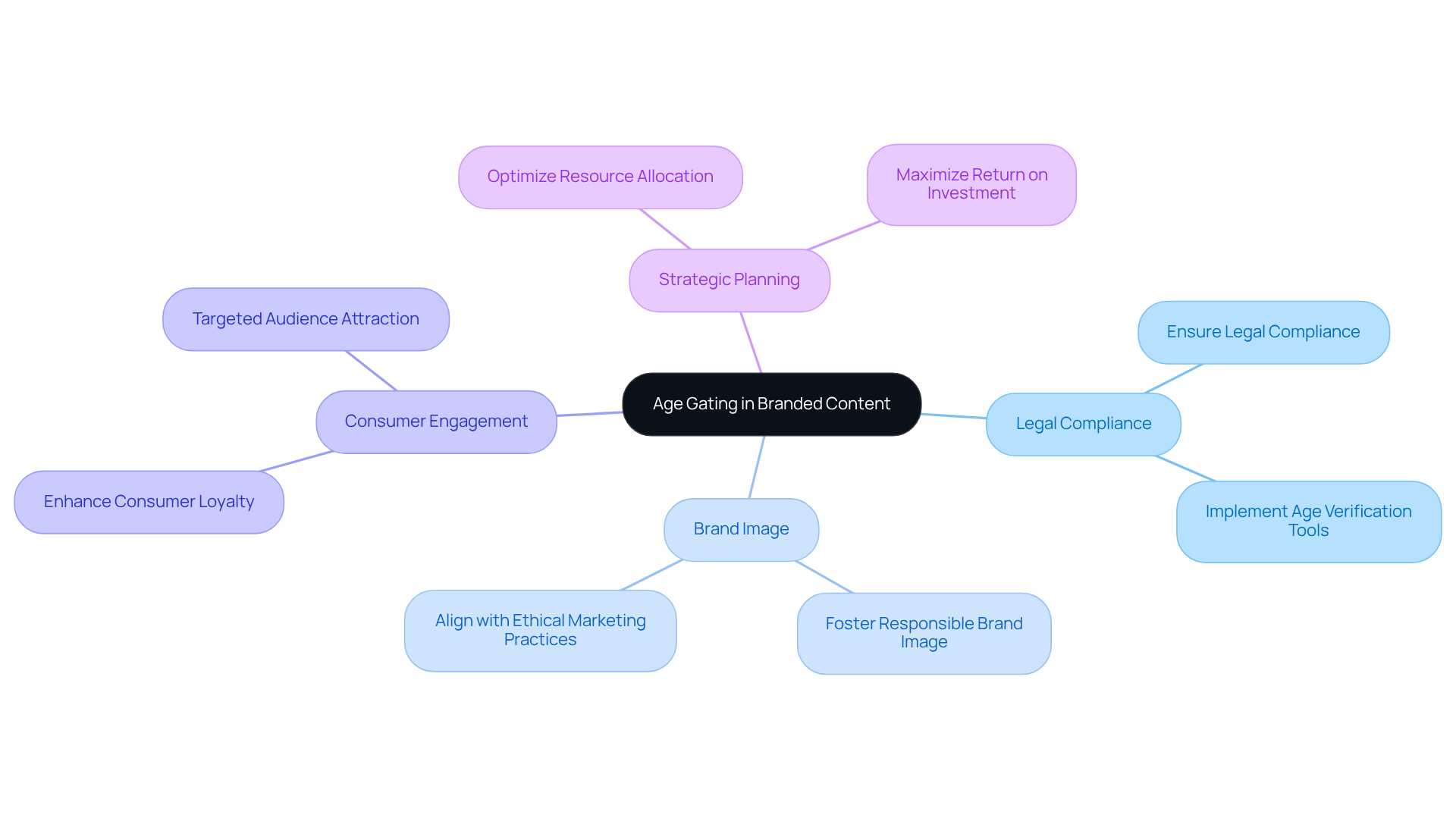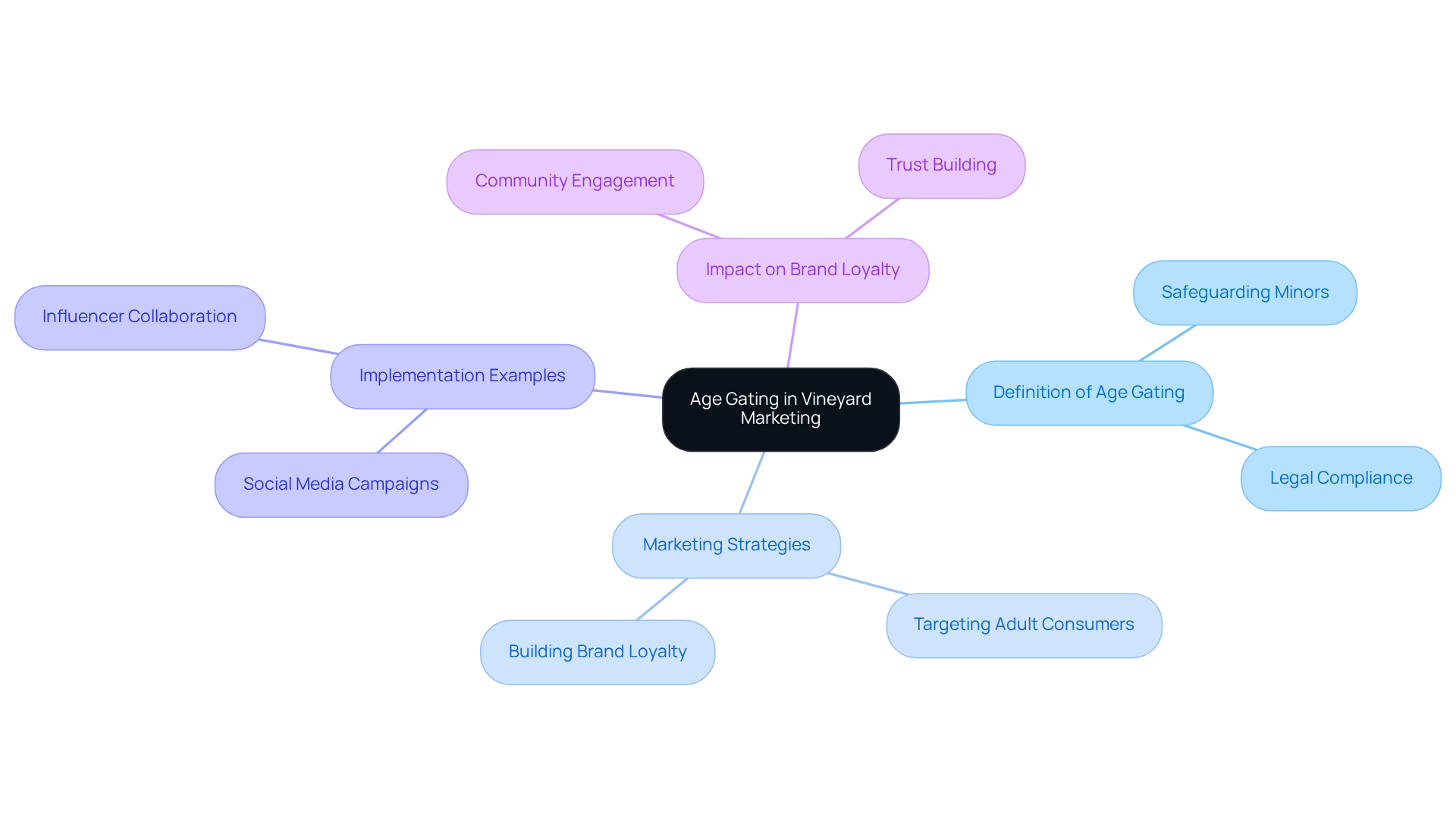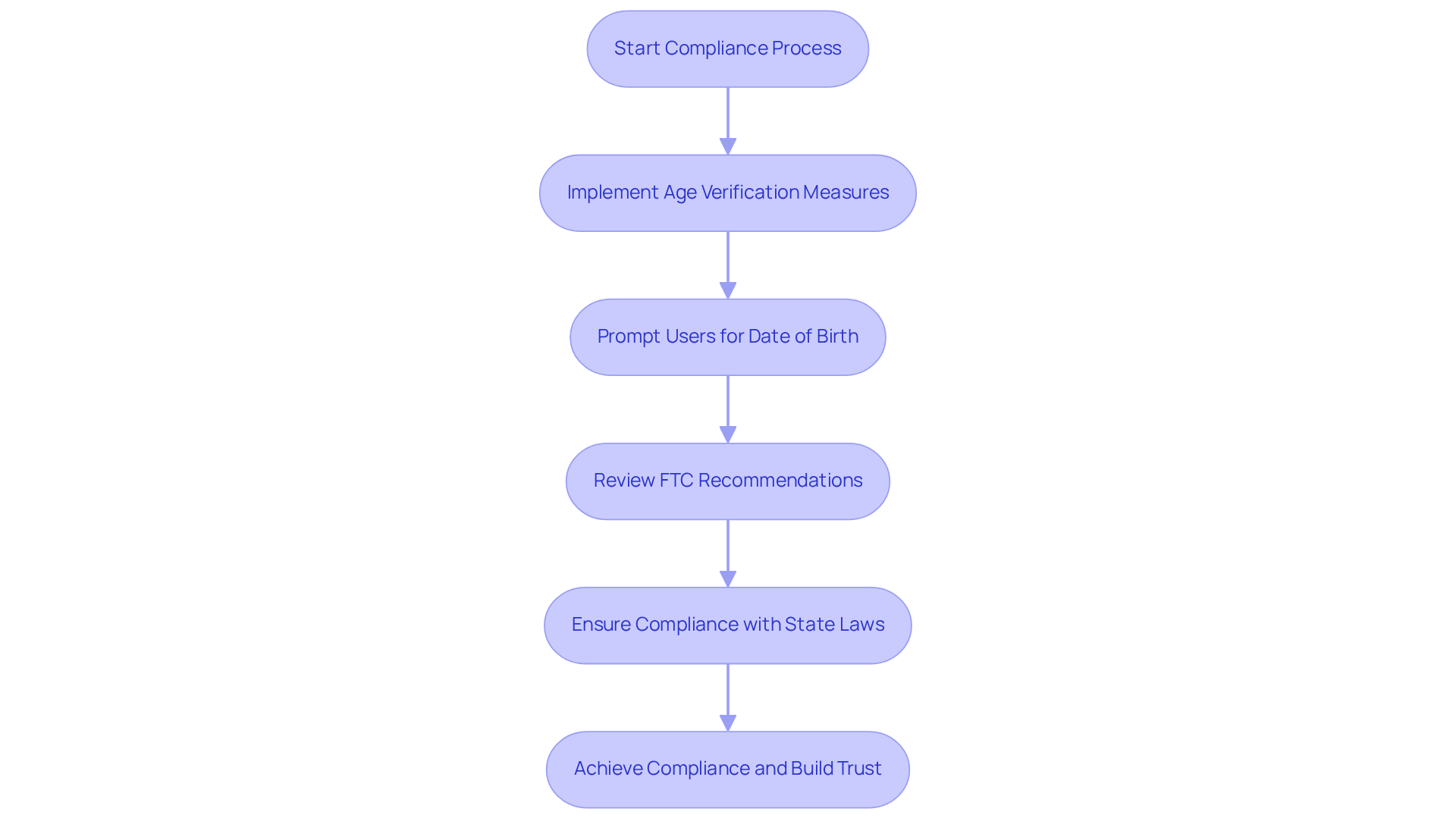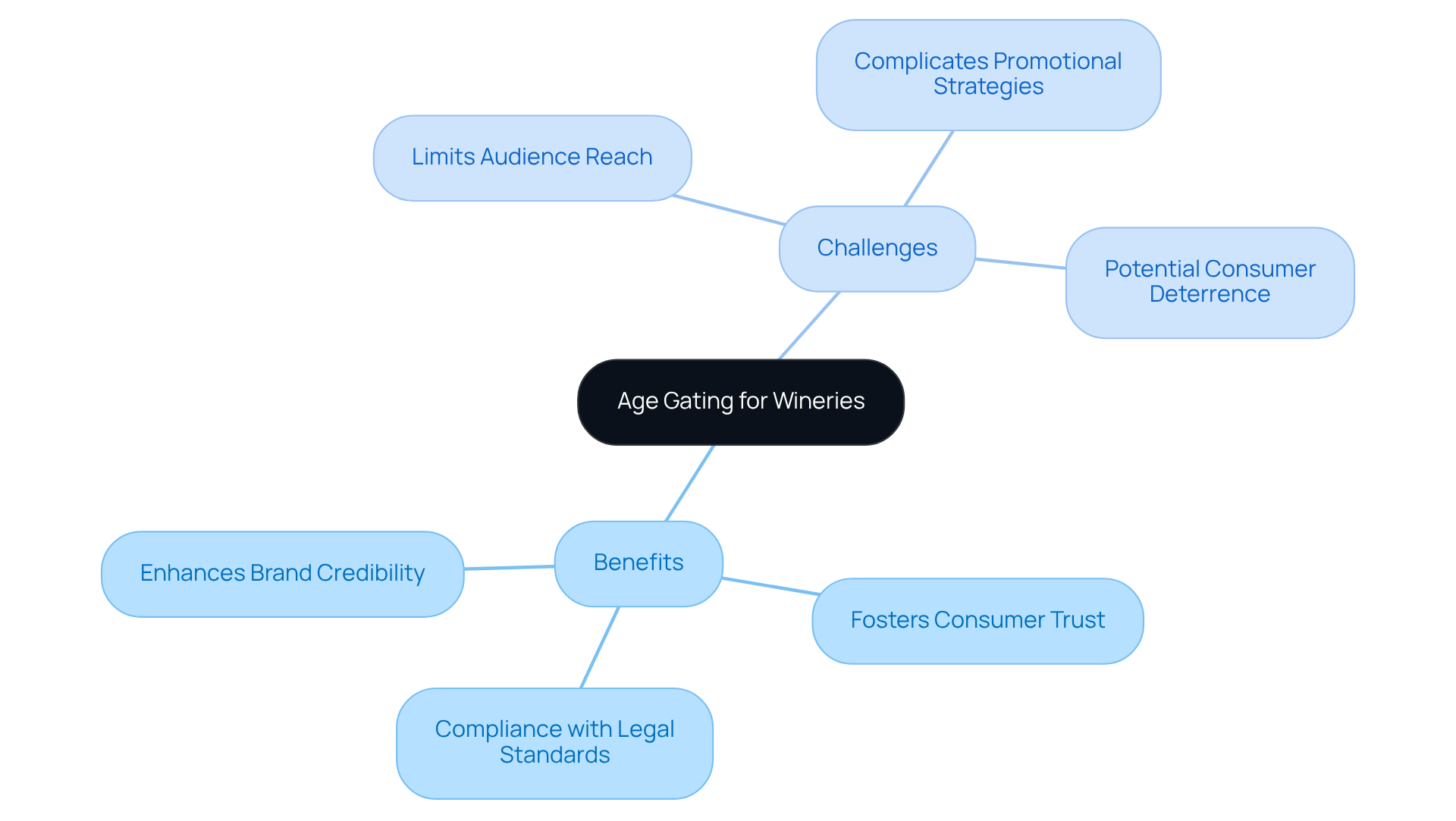Overview
Age gating stands as a pivotal practice for wineries, necessitating the verification of user age prior to granting access to alcohol-related content. This not only ensures compliance with legal regulations but also promotes responsible marketing.
By implementing age gating, wineries protect minors and enhance brand credibility. Furthermore, this practice fosters consumer loyalty by cultivating a secure environment for adult customers. In doing so, wineries align their marketing strategies with ethical standards and industry best practices, ultimately reinforcing their commitment to responsible engagement in the market.
Introduction
Age gating has emerged as a pivotal mechanism in the wine industry, designed to protect minors from accessing alcohol-related content while ensuring adherence to legal regulations. This practice not only shields wineries from potential liabilities but also bolsters their brand image by championing responsible consumption.
As vineyards navigate the intricate landscape of digital marketing, a pressing question arises: how can age gating be seamlessly integrated into their strategies to cultivate consumer loyalty and engagement without alienating potential customers?
Grasping the nuances of age gating is essential for wineries striving to excel in a competitive market while upholding ethical promotional practices.
Define Age Gating in Branded Content
Age restriction represents a critical practice in controlling access to online content based on user age, typically enforced through a pop-up or landing page that requires users to confirm their legal drinking age before engaging with age-sensitive materials, such as promotional content for alcoholic beverages. For vineyards, knowing what is age gating is essential for several compelling reasons.
- It ensures adherence to legal regulations, thereby safeguarding the winery from potential liabilities associated with underage exposure to alcohol promotion. Legal requirements for selling wine online mandate that age verification procedures be implemented at checkout to confirm that online wine customers meet the legal drinking age requirement.
- It fosters a responsible brand image by demonstrating a commitment to preventing minors from accessing alcohol-related content, aligning with industry standards and ethical marketing practices.
Moreover, age restrictions can positively influence consumer engagement and loyalty, which are key components of Enocap's transformative direct-to-consumer strategies. By establishing a barrier that underscores the exclusivity of their content, producers can enhance the perceived value of their brand. This strategy not only attracts a more targeted audience but also encourages among adult consumers.
For instance, a vineyard that effectively employs age restrictions can position itself as a frontrunner in responsible promotion, thus attracting consumers who appreciate ethical practices. As noted by industry specialists, understanding what is age gating can significantly enhance a vineyard's commitment to responsible promotion, ultimately bolstering customer trust and loyalty.
In an era where brand image is paramount, age restriction serves as a vital tool for wineries aiming to cultivate a reputable presence in the competitive alcohol market. Furthermore, strategic capital planning can be optimized through age restrictions by ensuring that promotional efforts target a suitable audience, thereby maximizing resource allocation and return on investment. The U.S. wine e-commerce market, which achieved a 3% share of total wine sales and generated over $1 billion in net sales by 2021, underscores the growing significance of age restrictions in this digital landscape.

Contextualize Age Gating in Marketing Strategies
What is , and how does it stand as a pivotal component of vineyard promotional strategies, particularly as digital platforms assume increasing significance? This practice not only safeguards minors from accessing alcohol-related content but also enables vineyards to focus their promotional endeavors on adult consumers, thereby fostering deeper engagement and loyalty, highlighting what is age gating.
By instituting age verification measures, wineries can nurture a responsible online environment that aligns with legal stipulations while effectively communicating what is age gating to their appropriate audience. Furthermore, age restrictions are instrumental in transforming casual buyers into committed club members, ensuring that promotional messages resonate with those legally permitted to purchase wine.
This targeted strategy can cultivate enhanced brand loyalty, as consumers tend to feel a stronger connection to brands that prioritize responsible promotional practices. Effective digital marketing tactics for vineyards frequently incorporate what is age gating as a foundational element.
For instance, vineyards can leverage social media platforms to disseminate captivating content while ensuring that only verified users gain access to promotional offers or exclusive events. This approach not only builds trust but also fosters a community of loyal customers who value the brand's dedication to responsible drinking.
In a market where 68% of buyers are swayed by wine influencers, age restrictions emerge as a strategic advantage. They empower vineyards to collaborate with influencers capable of authentically engaging adult audiences, thereby amplifying brand visibility and loyalty.
As the online alcohol delivery market continues to grow, projected to achieve a CAGR of 11.6% from 2021 to 2028, the implementation of age restrictions will be crucial for vineyards aiming to thrive in this competitive landscape.

Outline Regulatory Requirements for Age Gating
Regulatory requirements for age restrictions in the wine industry are crucial for preventing minors from accessing alcohol-related content. In the United States, the Federal Trade Commission (FTC) and various state laws mandate that wine producers implement age verification measures on their websites and promotional platforms. This typically involves prompting users to enter their date of birth or confirm their age through alternative methods. The FTC's reports from 2008 and 2014 specifically recommended that consumers visiting alcoholic beverage manufacturer websites be required to enter their date of birth, underscoring the importance of these measures.
Non-compliance with age restrictions can lead to significant penalties, including hefty fines and limitations on promotional practices. The FTC has consistently reviewed compliance within the alcohol industry, highlighting the necessity for adherence to self-regulation standards established by trade groups such as the Brewers Association and the Wine Institute. These organizations have developed codes that, while not legally mandated, strongly advocate for what is as best practices.
Wineries must remain vigilant regarding the legal requirements in their operating regions to effectively protect their brand and consumers. Successful examples of vineyards that demonstrate what is age gating include those that have integrated age verification gates on their websites, aligning with industry recommendations and ensuring responsible promotional practices. By adopting these measures, they not only comply with regulations but also cultivate trust and credibility with their audience.

Discuss Implications of Age Gating for Wineries
The implications of age restrictions for wineries are multifaceted and significant. Implementing age restrictions not only enhances brand credibility but also fosters consumer trust by demonstrating a commitment to responsible promotional practices. This strategic approach creates a secure environment for adult consumers to explore products and narratives, aligning with evolving regulations that mandate , effective in 2025. Furthermore, as Enocap emphasizes, establishing sustainable direct-to-consumer channels is vital for driving consistent growth within the wine industry.
However, age restrictions can also present challenges, such as potentially limiting audience reach and complicating promotional strategies. Some consumers may be deterred by the verification steps, which can adversely impact engagement metrics. Additionally, with 25% of consumers contemplating total abstention from alcohol and 37% intending to reduce their alcohol consumption, producers must navigate these shifting consumer preferences with care.
Despite these obstacles, the long-term benefits of protecting minors and ensuring compliance with legal standards—where non-compliance can result in substantial fines—often outweigh the drawbacks. As vineyards confront these complexities, age restriction emerges as a crucial element of modern marketing strategies, underscoring the importance of responsible messaging and brand integrity. Quotes from winery executives regarding the advantages of what is age gating could further illustrate its value in cultivating trust and credibility among consumers, aligning seamlessly with Enocap's mission to craft compelling stories that convert casual buyers into loyal club members.

Conclusion
Implementing age gating stands as a pivotal element in winery marketing, acting as a protective measure that guarantees compliance with legal regulations while promoting responsible consumption. By necessitating users to verify their age prior to accessing alcohol-related content, wineries not only shield minors but also cultivate a brand image that resonates with adult consumers. This practice transcends mere regulatory obligation; it serves as a strategic advantage that empowers wineries to build trust and loyalty among their target audience.
The discussion underscores several key aspects, such as:
- The critical nature of age verification in meeting legal standards.
- Nurturing a responsible brand image.
- Enhancing consumer engagement.
Age gating enables wineries to concentrate their marketing efforts on an appropriate audience, thereby optimizing resource allocation and amplifying return on investment. As e-commerce's significance in the wine industry escalates, the implementation of age restrictions has become increasingly essential in ensuring that promotional strategies resonate with the right consumers.
Ultimately, integrating age gating into marketing strategies is not solely about compliance; it embodies a commitment to ethical practices and consumer protection. As the online alcohol market continues to expand, wineries are urged to adopt age verification measures that align with industry standards. By doing so, they can not only avert potential legal repercussions but also cultivate a community of responsible consumers who value the brand's dedication to integrity and trustworthiness.
Frequently Asked Questions
What is age gating in branded content?
Age gating is a practice that controls access to online content based on user age, typically using a pop-up or landing page that requires users to confirm their legal drinking age before accessing age-sensitive materials, such as promotional content for alcoholic beverages.
Why is age gating important for vineyards?
Age gating is important for vineyards as it ensures adherence to legal regulations, protects the winery from potential liabilities related to underage exposure to alcohol promotion, and fosters a responsible brand image by preventing minors from accessing alcohol-related content.
How does age gating impact consumer engagement and loyalty?
Age gating can positively influence consumer engagement and loyalty by creating a barrier that emphasizes the exclusivity of content, enhancing the perceived value of the brand, attracting a more targeted audience, and encouraging responsible consumption among adult consumers.
What benefits does a vineyard gain from effectively employing age restrictions?
A vineyard that effectively employs age restrictions can enhance its reputation for responsible promotion, attract consumers who value ethical practices, and ultimately bolster customer trust and loyalty.
How does age gating relate to a winery's brand image?
Age gating serves as a vital tool for wineries aiming to cultivate a reputable presence in the competitive alcohol market, demonstrating a commitment to responsible marketing practices and aligning with industry standards.
What role does age gating play in strategic capital planning for wineries?
Age gating optimizes strategic capital planning by ensuring that promotional efforts target a suitable audience, maximizing resource allocation and return on investment.
What is the significance of age restrictions in the U.S. wine e-commerce market?
The U.S. wine e-commerce market, which achieved a 3% share of total wine sales and generated over $1 billion in net sales by 2021, highlights the growing importance of age restrictions in effectively navigating the digital landscape for wine sales.




